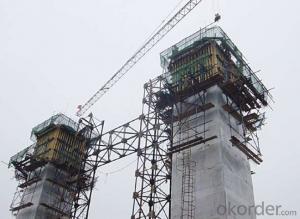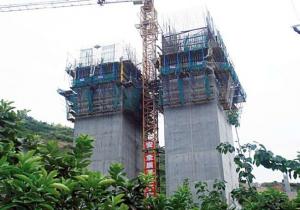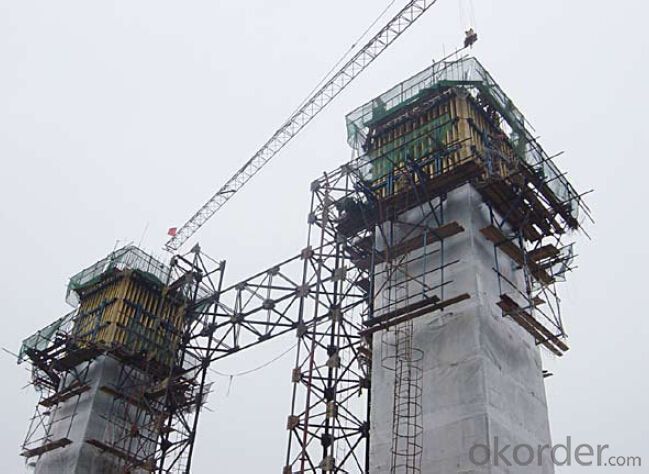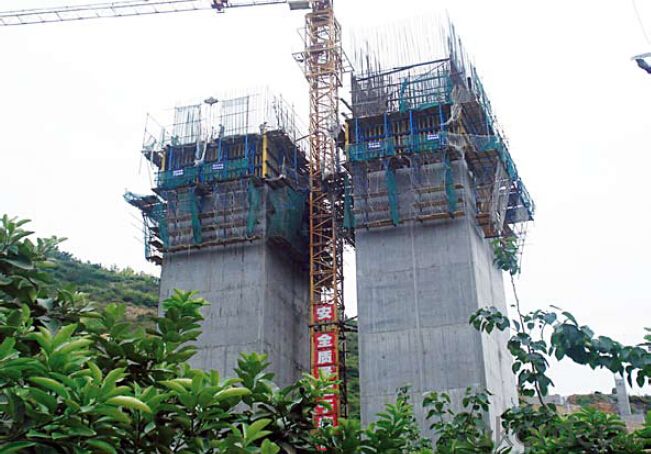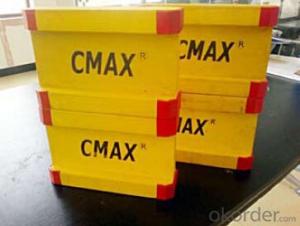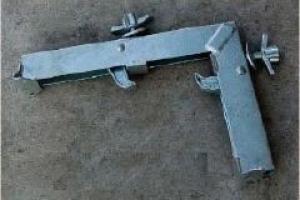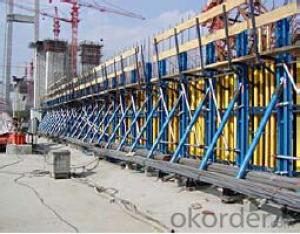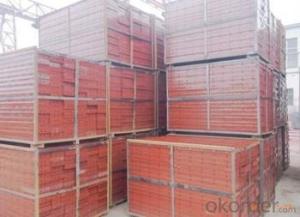Climbing-Bracket for formwork and scaffolding system
- Loading Port:
- Tianjin
- Payment Terms:
- TT OR LC
- Min Order Qty:
- 50 m²
- Supply Capability:
- 1000 m²/month
OKorder Service Pledge
OKorder Financial Service
You Might Also Like
Climbing Bracket CB240 & CB210
They are framework brackets for supporting large-area wall formwork.
Typical applications for the CB240&CB210 are pier and column/shear wall/core walll/ in the
building.
CB210 has smaller size than CB240, it will be cost effective in some condition.
Characteristics:
◆ High bearing capacity
The high loading capacity of the brackets allow very large scaffold units. This saves the number
anchor points required as well as reducing climbing times.
◆ Simple moving procedure by crane
Through the strong connection of formwork together with the climbing scaffold, both can be moved
as a single climbing unit by crane. Thus valuable time-savings can be achieved.
◆ Fast striking process without a crane
With the retrusive set, large formwork elements can also be retracted quickly and a minimum of
effort.
◆ Safe with work platform
The platforms have assembled firmly with bracket and will be climbing together, without scaffolding
but can work safely in spite of your high location.
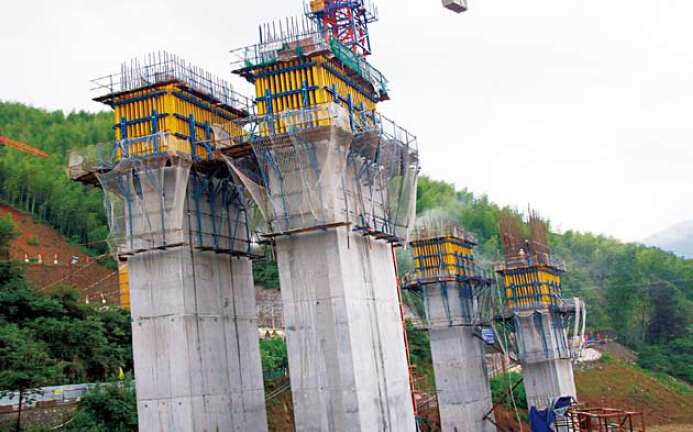
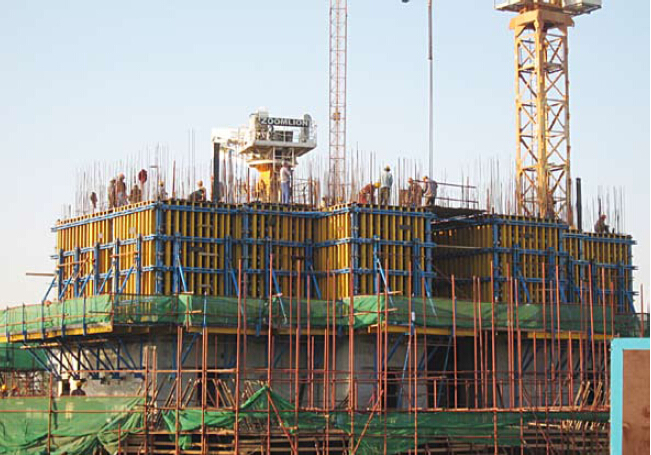
- Q: Can steel formwork be used for both straight and curved walls?
- Yes, steel formwork can be used for both straight and curved walls.
- Q: What are the different edge protection systems available for steel formwork?
- There are several different edge protection systems available for steel formwork, each designed to provide safety and support for construction workers. One common edge protection system is the use of guardrails. These guardrails are typically made of steel or aluminum and are installed along the edges of the formwork to prevent workers from falling off. They are often adjustable in height and can be easily installed and removed as needed. Another type of edge protection system is the use of safety nets. These nets are installed below the formwork and act as a safety barrier to catch any workers or materials that may fall. Safety nets are typically made of high-strength synthetic fibers and are designed to absorb the impact of a fall, reducing the risk of injury. Some edge protection systems also include toe boards. Toe boards are installed along the bottom edge of the formwork to prevent tools, equipment, or materials from falling off and potentially causing injury. They are typically made of wood or metal and are securely attached to the formwork. In addition to these systems, there are also edge protection solutions that incorporate a combination of guardrails, safety nets, and toe boards. These comprehensive systems provide multiple layers of protection to ensure the safety of workers on the construction site. Overall, the different edge protection systems available for steel formwork are designed to prevent falls, protect workers, and ensure a safe working environment. It is important for construction companies and workers to carefully assess the specific requirements of their project and select the appropriate edge protection system to meet their needs.
- Q: Can steel formwork be used for both manual and mechanical concrete pouring?
- Indeed, both manual and mechanical concrete pouring can utilize steel formwork. Renowned for its robustness and sturdiness, steel formwork is apt for handling the immense pressure and weight of concrete, regardless of the pouring method employed. It furnishes a steadfast and inflexible framework that endures the strains exerted during the pouring and setting of concrete. Moreover, steel formwork is adaptable and can be effortlessly modified or reconstructed to accommodate diverse configurations and dimensions of concrete structures. Consequently, it is frequently employed in construction ventures that employ both manual and mechanical concrete pouring techniques.
- Q: How does steel formwork contribute to improved construction site access?
- Steel formwork contributes to improved construction site access by providing a strong and durable structure that allows for easy and safe movement of workers, equipment, and materials. Its robustness ensures that it can withstand heavy loads and constant use, minimizing the risk of accidents or collapses. Additionally, steel formwork can be easily assembled and disassembled, allowing for efficient and quick access to different areas of the construction site. Its versatility also enables the creation of customized shapes and sizes, adapting to the specific needs of each project and ensuring smooth and unrestricted access throughout the construction process.
- Q: What are the different types of steel formwork systems available in the market?
- In the market, one can find a variety of steel formwork systems that cater to specific construction needs and requirements. 1. The most commonly used steel formwork system in construction projects is the traditional steel formwork. It involves assembling steel plates and angles to create a temporary mold for concrete placement. This type of formwork is versatile and suitable for various structures. 2. Another type is the modular steel formwork system, which comprises pre-made modular panels that interconnect to form a mold for concrete placement. It is lightweight, easy to assemble and disassemble, and can be reused multiple times, making it cost-effective and time-efficient. 3. For tunnel and underground structure construction, tunnel formwork systems are designed. They utilize steel plates assembled to create a continuous mold along the tunnel's length. These systems are durable, capable of withstanding high pressures, and provide a smooth finish for the tunnel walls. 4. Climbing formwork systems are commonly used in high-rise construction projects. They feature a self-climbing mechanism that allows the formwork to be vertically raised or lowered as the construction progresses. By eliminating the need for cranes or external support, these systems are efficient and safe. 5. Slip formwork systems are employed for tall and slender structures like towers and chimneys. They involve a continuously moving formwork that is raised vertically as the concrete hardens. These systems ensure a smooth and uniform finish while being highly efficient for large-scale construction projects. These examples demonstrate the variety of steel formwork systems available in the market. The selection of a system depends on factors such as the type of structure, project timeline, budget, and specific construction requirements. It is crucial to consult with experts and consider these factors before choosing the most suitable steel formwork system for a project.
- Q: Can steel formwork be used for hospital construction projects?
- Indeed, hospital construction projects can make use of steel formwork. This construction material, known for its versatility and durability, brings forth numerous advantages for such projects. Notably, it offers outstanding strength and stability, crucial factors in ensuring the building's safety and integrity. Moreover, steel formwork enables efficient and precise construction due to its ease of assembly and disassembly. Its modular nature also permits flexibility in design and layout changes. Another noteworthy feature is its smooth surface finish, which plays a vital role in maintaining a hygienic environment within a hospital setting. Furthermore, steel formwork exhibits resistance to moisture and chemicals, making it suitable for areas requiring frequent cleaning and sterilization. Overall, when it comes to hospital construction projects, steel formwork proves itself as a reliable and suitable option.
- Q: Can steel formwork be used for swimming pool construction?
- Yes, steel formwork can be used for swimming pool construction. Steel formwork offers durability and strength, making it suitable for creating the required concrete structure of a swimming pool. It is commonly used in the construction industry for various applications, including swimming pool construction.
- Q: What are the common safety precautions when working with steel formwork in extreme temperatures?
- When working with steel formwork in extreme temperatures, it becomes imperative to implement specific safety measures in order to safeguard the workers' well-being and successfully complete the project. Consider the following essential safety precautions: 1. Adequate Personal Protective Equipment (PPE): Workers must wear suitable PPE, including heat-resistant attire, gloves, and safety goggles, to shield themselves from extreme temperatures and potential hazards. 2. Regular hydration: It is crucial to ensure that workers stay hydrated when faced with extreme temperatures. Encourage frequent breaks for water consumption and provide access to cool drinking water on-site. 3. Provision of shaded and rest areas: Establish shaded spaces or rest zones where workers can take breaks and escape direct exposure to heat. This will help prevent heat-related illnesses such as heat exhaustion or heat stroke. 4. Training and awareness: Guarantee that all workers receive proper training and education regarding the potential risks associated with working in extreme temperatures. They should be knowledgeable about the signs of heat-related illnesses and be prepared to respond in emergency situations. 5. Monitoring weather conditions: Regularly check weather forecasts and stay informed about extreme temperature warnings or heat advisories. If possible, adjust work schedules to minimize exposure to extreme heat. 6. Implementation of a buddy system: Establish a buddy system where workers can watch out for each other. This ensures that any heat-related issues can be promptly identified and addressed. 7. Regular breaks and scheduling: Plan work schedules in a manner that allows for frequent breaks and rest periods. This helps prevent overexertion and reduces the risk of heat-related illnesses. 8. Proper ventilation: Ensure that the work area is adequately ventilated to facilitate air circulation and minimize heat accumulation. This can be achieved through the use of fans or natural ventilation methods. 9. Regular communication: Maintain open lines of communication with workers to monitor their well-being and address any concerns they may have regarding working in extreme temperatures. 10. Emergency response: Establish a well-defined emergency response plan that includes procedures for handling heat-related emergencies. This should encompass providing first aid, accessing medical assistance, and evacuating the work area if necessary. By adhering to these common safety precautions, workers can mitigate the risks associated with working in extreme temperatures while utilizing steel formwork, thereby ensuring a safe and productive work environment.
- Q: Can steel formwork be used in seismic zones?
- Steel formwork is indeed capable of being employed in seismic zones. Steel possesses formidable strength and durability, enabling it to endure the formidable forces unleashed during an earthquake. The material exhibits a remarkable ability to flex and absorb energy, rendering it highly suitable for deployment in seismic zones. Furthermore, steel formwork confers stability and rigidity upon the structure, guaranteeing its ability to withstand the quivering and shifting caused by seismic activity. Nonetheless, it is essential to take into account other factors such as design, construction techniques, and local building codes to ensure the correct installation and compliance of the steel formwork system with the specific requirements of the seismic zone.
- Q: Can steel formwork be used for both flat and sloped concrete surfaces?
- Yes, steel formwork can be used for both flat and sloped concrete surfaces. Steel formwork is highly versatile and can be easily adjusted and shaped to accommodate different angles and slopes during the concrete pouring process. Its strength and rigidity make it suitable for supporting the weight and pressure of the concrete, ensuring a smooth and uniform finish regardless of the surface inclination.
Send your message to us
Climbing-Bracket for formwork and scaffolding system
- Loading Port:
- Tianjin
- Payment Terms:
- TT OR LC
- Min Order Qty:
- 50 m²
- Supply Capability:
- 1000 m²/month
OKorder Service Pledge
OKorder Financial Service
Similar products
Hot products
Hot Searches
